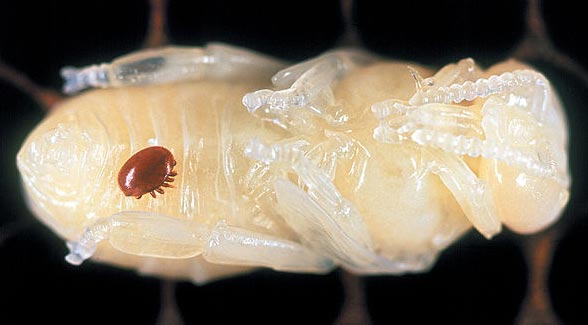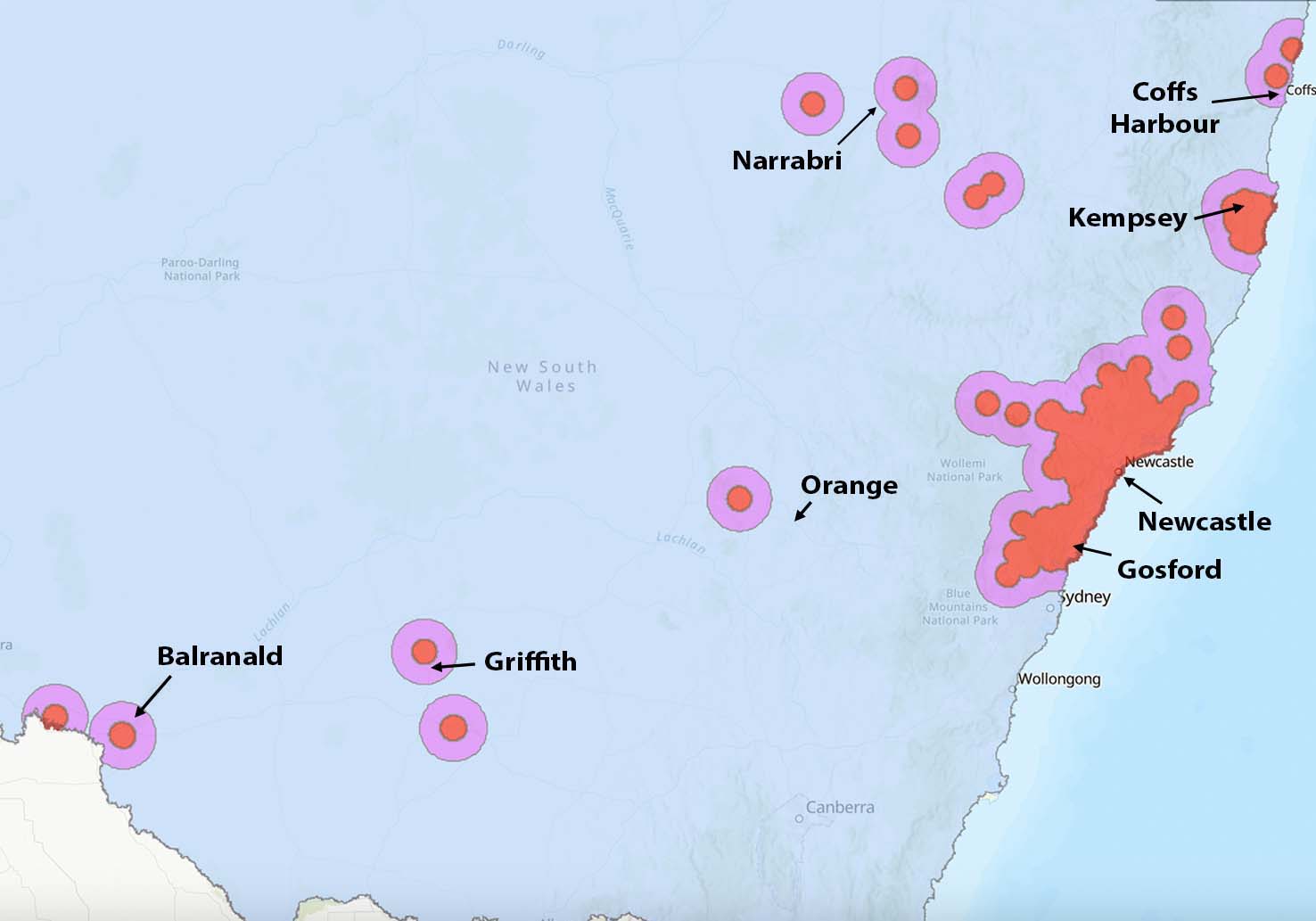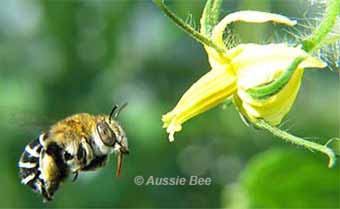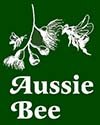THE IMPACT OF VARROA MITES IN NEW SOUTH WALES
******** UPDATE ******** On 19 September 2023, the NSW DPI Varroa Mite Eradication Program came to an end. The DPI baiting program, using the toxic pesticide, Fipronil, also ended on 19 September 2023. However, active pesticide residues from earlier baiting work, going back to late 2022, may still be in the environment in some areas. Updated advice for people who wish to keep native bees in an affected area can be found below. |
How will Varroa Mites affect native bees &
What you can do to help!
Aussie Bee > Native Bees and the Varroa Mite Crisis
by Dr Anne Dollin,
Australian Native Bee Research Centre
UPDATED: Sunday 11 February 2024, 3.00pm
Topics:
1. The situation so far.
2. How will Varroa Mites affect native bees?
3. How has the eradication effort affected native bees?
4. Do you wish to keep native bees in a DPI Red Zone? WHAT TO DO NOW.
5. How native bees could help save Australian agriculture.

Above: a red-brown Varroa Mite parasite on a developing European honeybee. Image by Denis Anderson.
1. The situation so far
Varroa Mites, devastating parasites of European honeybees, were discovered in honeybee hives at Newcastle, NSW, on 22 June 2022. Sadly, by 15 September 2023, surveillance by the NSW Department of Primary Industries (DPI) revealed that Varroa Mites had spread to 277 locations in NSW (see Red Zones on map below).

Above: The DPI declared Red Zones around each site where Varroa Mites were detected. Until 19 September 2023, the DPI ran a toxic Fipronil baiting program in most of these Red Zones, in an attempt to eradicate the Varroa Mites.
Drastic steps were taken by the DPI to try to eradicate this Varroa Mite incursion. About 30,000 managed European honeybee hives were euthanised in the Red Zones shown in the map above and a baiting program to destroy feral nests of European honeybees was progressively rolled out in these areas.
Finally, on 19 September 2023, the National Management Group controlling the response made the decision that it was no longer feasible to eradicate the Varroa Mites from Australia. The Varroa Mite eradication work, including the toxic baiting program, ended, and apiarists began work to manage this pest in their European honeybee hives instead.
Varroa Mites still remain active within large areas of NSW, especially in the Newcastle, Central Coast and Kempsey areas. Varroa Mites do not directly affect native bees (see Section 2). However, the after-effects of the DPI baiting program may continue to impact native bees for some time in some areas (see Section 3).
2. How will the Varroa Mite affect native bees?
Fortunately, research has shown that Varroa Mites cannot attack Australian native bees directly, as native bees have a very different biology from European honeybees.
Other flow-on effects are still possible though. Mite-infested hives of European honeybees may carry high levels of bee viruses and some of these viruses may spill over to native bees. Read more.
Varroa Mites, as they spread, will drastically reduce the number of feral European honeybee nests in the bush. This will reduce competition for nectar and pollen resources in the bush, which should benefit some native bee populations.
On the other hand, from late 2022 until September 2023, the DPI attempted to destroy all feral European honeybees in the Red Zones, using sugary baits containing Fipronil, a highly toxic pesticide. This baiting work has now ended. Nevertheless, residual pesticide in the environment could still impact native insects in some of these areas.
3. How has the eradication effort affected native bees?
In an effort to rid Australia of this devastating European honeybee parasite, the DPI tried to destroy all feral European honeybee colonies that were nesting in tree cavities in the Red Zones. By September 2023, the combined Red Zone areas covered over 1.5 million hectares.
The DPI eradication effort in the Red Zones involved the use of baits laced with the highly toxic pesticide, Fipronil. Pesticide residues in the environment could still impact local native bees and other pollinators in some of these areas.

Above: The DPI declared Red Zones around each site where Varroa Mites were detected. Until 19 September 2023, the DPI ran a toxic Fipronil baiting program in most of these Red Zones, in an attempt to eradicate the Varroa Mites.
During the baiting program, many feral European honeybee foragers visited the baiting stations and took Fipronil back to their nests, killing these colonies. Fipronil can remain active in honey for over two years (see reference 1). So, the stored honey in these poisoned feral European honeybee nests could still endanger native bees that are in some of these Red Zones for a long time (see reference 2).
Unfortunately, it is difficult to know how much Fipronil could still be in the environment in a particular Red Zone, as this depends on many factors. For instance:
1. The length of time that baiting was done in a particular Red Zone. In some Red Zones, Fipronil was used in the baiting stations as early as October 2022 and two cycles of baiting (each three months long) were completed. In other Red Zones, only one baiting cycle was completed. In some Zones, no baiting work was done at all.
2. How well the baiting worked in a particular Red Zone. In some Red Zones, the baiting program was successful -- many feral European honeybees visited the baiting stations, and many feral nests were killed by the Fipronil pesticide. In other Red Zones, the baiting was unsuccessful -- few feral honeybees visited the baiting stations (due to the weather, a local abundance of natural nectar, or other reasons), and few feral honeybee nests were killed by the Fipronil pesticide.
3. South African Small Hive Beetles destroying dead feral honeybee nests in some areas. There have been reports from some Red Zones that the exotic Small Hive Beetles quickly infested the poisoned feral European honeybee nests. Evidently, Small Hive Beetles are much less affected by Fipronil than bees are. Honey stores that are infested by Small Hive Beetles become putrid and unattractive to native bees. Therefore, in these areas, there would be few Fipronil-contaminated feral European honeybee nests left that could impact our native bees.
For the above reasons, the risk of Fipronil poisoning in each Red Zone must be assessed individually by people with local knowledge of that area.
If you would like to keep native stingless bees in a Red Zone now, read Section 4, below.
4. Do you wish to keep native bees in a DPI Red Zone? WHAT TO DO NOW.
Native bees in the Red Zones (see map above) could be exposed to Fipronil, a highly toxic pesticide. Until 19 September 2023, the DPI Varroa Mite eradication program used Fipronil to poison feral European honeybee nests in the Red Zones (see details in Section 3, above). Honey in these dead nests may be contaminated with Fipronil and this pesticide could remain active for about two more years.
However, as explained in Section 3, the actual amount of Fipronil that remains in each Red Zone may vary a great deal and needs to be assessed individually.
We recommend that native bee hive owners in a Red Zone make local enquiries to assess for themselves if it is safe to keep stingless bees in their location now. For instance:
-- Have any apiarists brought their hives of commercial European honeybees back to your area and, if so, how healthy are those hives now?
-- Are there any other hives or natural nests of native stingless bees in your area, and, if so, how healthy are those bees now?
5. How native bees could help save Australian agriculture.
This crisis highlights the vital importance of developing native bees as alternative pollinators for Australian agricultural crops. As Varroa Mites gradually spread across the country, massive losses of European honeybees will occur throughout Australia. The pollination services of native bees and other insects will become crucial to support Australian agriculture.
Recent research in Australia has demonstrated that native bees, including our stingless bees and blue banded bees, can be effective pollinators of many Australian agricultural crops. Other Australian native insects, including flies, beetles, butterflies and wasps, also contribute important pollination services to crops.
New crop management systems, which help Australian native bees and other insects to perform their vital pollination services for our Australian agriculture, must be developed as a matter of great urgency!



